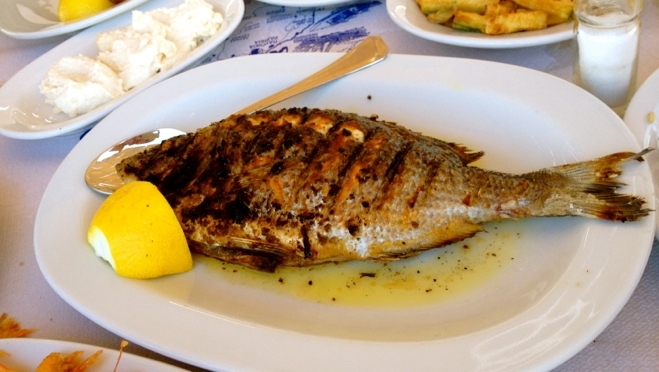While 80% of Greece is mountainous, you associate Greece with the sea, and Greeks have a very strong sea culture. Let’s not forget that Greece has a coastline of over 13000 km making it the country with second largest coastline in Europe. Fish have always had a special position in Greece. In antiquity it was a major part of the local diet and the main source of protein. In modern Greece they are equally special. The photos above are significant because they show how common and important fish was in the daily life in Greece. The illustrations are from a Greek school book first published in 1955, it was used in Greek schools until 1978. Every time I see these photos, especially the one with the mother holding fresh fish and the daughter bringing the olive oil and the pan to fry them, I remember the smell of frying fish taking over the whole neighborhood and how it tasted so good.
Fish consumption in the traditional Mediterranean diet was mainly limited to small fish like sardines and anchovies sometime fresh, but many times salted or marinated. Those who lived near the coast had easier access to fresh fish while those who lived in mountainous areas bought their fish from the fishmonger who would come once or twice a week in summer, less often in the winter.
Apart from eating fish at home, going out for fish is a special occasion. Taking someone out for fish in Greece is the equivalent of taking out someone for a filet mignon if you were to eat meat. It is the ultimate honor for your guest. When I say fish, in this case it is usually supposed to be some huge extravagant fish grilled and accompanied by one of my favorite sauces latholemono (olive oil and lemon-see recipe below) and simple steamed vegetables or boiled horta (wild greens). Since the fish is the centerpiece, there is no need for rich appetizers or complex side dishes.
The Art of Eating Fish
There is a whole ritual for fish eating in Greece. First you have to ask what fish do they have today. Once the waiter tells you, you then have to go in the kitchen and look at the fish and choose the one you want, then they weigh it for you and you have to decide how it will be cooked. All these steps require that you know a bit about how a fresh fish looks like, or actually what a whole fish looks like. Considering that many of us are used to eating fish fillets or even fish sticks, a whole fish on the table maybe a bit shocking to some, but in Greece it is not only common, it is a way of knowing where the fish you are eating is coming from. Some simple guidelines: fresh fish should smell like the sea, their eyes should be shiny, the scales should be shiny and attached to the body and the gills should be red. There should be no mushiness or dullness or brownness anywhere.
How to Choose Fish in Greece
Initially it is important to know when is the season of each fish, and when it is available in Greece. I asked Pantelis Koutsoulentis who as been selling fish wholesale for more than 20 years, and he gave me some tips on choosing and buying fish.
According to Koutsoulentis, there may be fish in every season, but that does not mean that you can find them. Generally, it is advisable to choose fish that do not swim at great depths. Good choices as anchovies, sardines, mackerel, bogue (type of sea bream), and pike. These fish may be considered common but they are not so expensive, plus they will be fresh and Greek, and most importantly, the are richer in the good fatty acids.
You may see larger fish on the menu, but that does not necessarily mean they are from Greek waters. According to Koutsoulentis, these fish are scarce in the summer months and they import them from countries like Senegal, Tunisia and Morocco. To find such fish from Greek waters you should either go to a secluded island where there is not much traffic, or somewhere that you can trust provides Greek fish.
Well I knew just the place here in Athens. I headed over to Milos restaurant (they also have locations in NYC, Montreal, Las Vegas and Miami) with chef Pericles Koskinas. I had tasted Pericles creations at the recent Greek Gastronomy event Sani-Gourmet and he just has a special culinary relationship with fish and generally seafood, somehow keeping it simple and letting the flavor of the fish come out. What is impressive is that he gives so many different dimensions to fish using traditional techniques but at the same time keeping it fresh. So considering the rich fish culture in Greece, I asked him if there are some unique fish and shellfish one should try to find (and taste) when in Greece, here are his suggestions:
- Pearly Razorfish from the island of Aegina (Katsules). These are small fish that basically swim through the sand. According to Pericles these can be consumed lightly fried.
- Bullhead from the Aitoloko Lagoon in the west of Greece (Govioi). This fish is enjoyed steamed with garlic and white pepper.
- Skate (Salahi) from the island of Limnos steamed with fresh dill and spring onion or bourtheto (cooked in tomato sauce).
- Wild oysters from the island of Kimolo, enjoyed of course raw.
- Kalognomes a type of shellfish known as arca noae from the Ionian sea, roasted on the grill.
Latho-Lemono (Olive Oil-Lemon Dressing)
This dressing is served with grilled fish (not fried) as there has been no other fat added during preparation. The dressing brings out the taste of the fish. And of course olive oil, lemon and oregano are excellent sources of potent antioxidants making the fish even more nutritious.
2 Parts Olive Oil
1 Part Lemon
Oregano to taste
Add everything in a bowl or a jar, mix until sauce starts to thicken.




Wow, what a blast from the past… I haven’t seen those old textbook photos since the mid-late 1980s, thanks for the memories lol
I was just about to mention Milos, one of the top restaurants in Montréal, and certainly the one where I’d asked to be invited if money were no object. I knew they had also opened a restaurant in NYC, but didn’t know they actually had one in Athens
It is of course a pricy restaurant, but they have a remarkable lunch menu deal here, and googling, it seems they do at some of their other cities. http://milos.ca/restaurants/montreal/menus/lunch
Hi Elena,
I love all your fish recipes, but wondered on average how many times a week does a Greek eat fish? Are you concerned about all the talk about mercury contamination supposedly in the fish, especially the larger ones?? Maybe in Greece you can get cleaner fish than here in the US. Just wanted to know your thoughts about this issue or if you think mercury contamination in fish is overblown. Thanks! Love your site! Annette
Such an excellent and precise article! Unfortunately (according to my experience), quality, fresh seafood is a bit of a rare find in fish-tavernas. It is a bit of a disappointment that our choices are usually limited to shrimp, mussels and clams at best.
Thank you Konstantina!
Διάλεξες πολύ ωραίες φωτογραφίες από το παλιό αναγνωστικό.
Τι ωραία μηνύματα πέρναγαν. Η οικογένεια έτρωγε ψάρι κι όχι κάτι άλλο.
Πολύ ωραίες πληροφορίες για το ψάρι.
Μπράβο!
Σε ευχαριστώ Marion! Πράγματι είναι σημαντικό ότι έτρωγαν ψάρι.
Loved this post! I’m very particular about fish so this was right up my alley. Will try the dressing this weekend!
Thanks Meri! You can add other herbs in the dressing too.